Patchy Reefs That Deserve our Attention
First published in Sanctuary Asia,
Vol. 44
No. 8,
August 2024
By Sumer Rao
A little-known marine ecosystem thrives just beneath the green waves that lap India’s southwestern coast. The patchy coral reefs of the Konkan coast are found in sporadic pockets from Maharashtra to Karnataka, and are a stark contradiction to almost everything the global narrative for reefs sells. These underwater metropolises persist despite being plagued by turbid waters, perpetual low-light conditions, and exposure to anthropogenic stressors that stem from their close proximity to the Indian mainland.
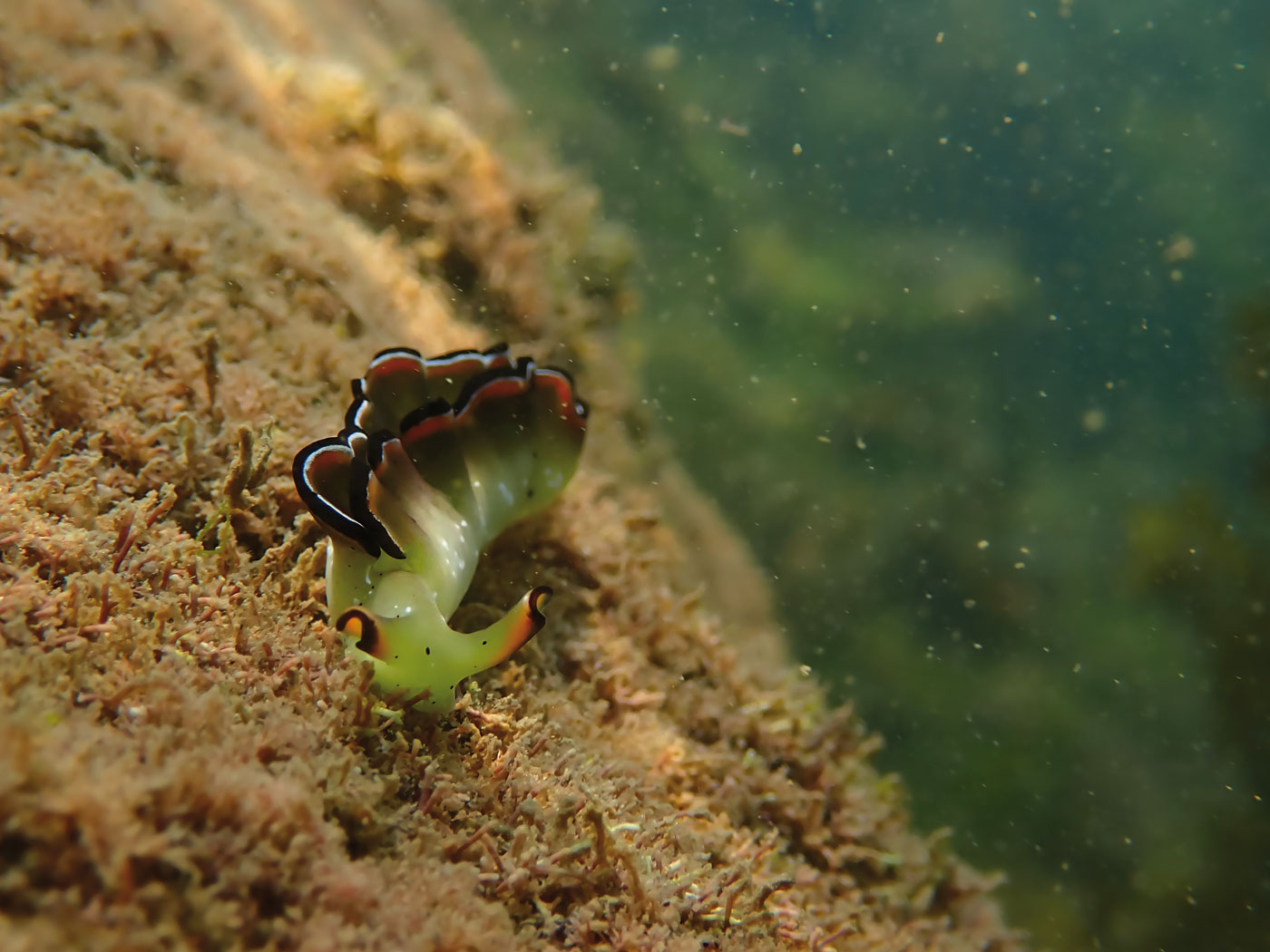
An ornate sap sucking slug Elysia ornata makes its way through the shallows. These slugs are known as solar powered sea slugs for their ability to capture, nurture and harness chloroplasts from the algal sap they consume, and photosynthesise – generating a portion of their own food. Photo: Sumer Rao.
Some of the larger known reef systems along this coastline include the reefs of the Grande Island complex in Goa; the Malvan Marine Sanctuary and the fabled Angria Bank in Maharashtra; and Netrani Island in Karnataka. These sites are distributed at different distances from the coast, with Malvan’s reefs beginning a little after the low-tide mark. The Grande Island complex, a group of three islands – Grande, St. George and Pequeno, are situated between three and five kilometres offshore, directly perpendicular to the city of Vasco De Gama. Netrani Island lies about 10 km. into the sea from the temple city of Murudeshwar. Angria Bank – an expansive plateau situated 100 km. off the coast of Ratnagiri – remains the least explored of the Konkan reefs, which gets sanctuary through its relative isolation.
I first dived in Goa in 2022. These dives were meant to be a follow-up on some of the early surveys undertaken by WWF India in 2018. We had spent weeks planning and deciding our sampling sites and protocol. As part of our reef assessments, we were conducting fish counts to estimate the biomass of different functional groups of herbivorous reef fish. Through their unique feeding behaviours and dietary preferences, these fish contribute towards the reef’s capacity to endure and recover from stressors such as prolonged warming events.
After much deliberation, we decided to use point intercept transects as our method. This involves randomly selecting points during a dive and conducting fish counts for five minutes, within a five-metre radius of the selected point. Our first site was off the south-eastern tip of Grande Island, called Coral Garden after its vast swathes of plate coral colonies. We wore our kit in the water, made sure we had all our equipment, and began descending. The water was filled with heavy sediment and I remember the first thought in my mind, “How in the world are we going to count fish here?” I could barely see my hands! We had to abandon the dive 10 minutes in. On the boat journey home, our divemaster assured us that visibility would get better.
And it did.
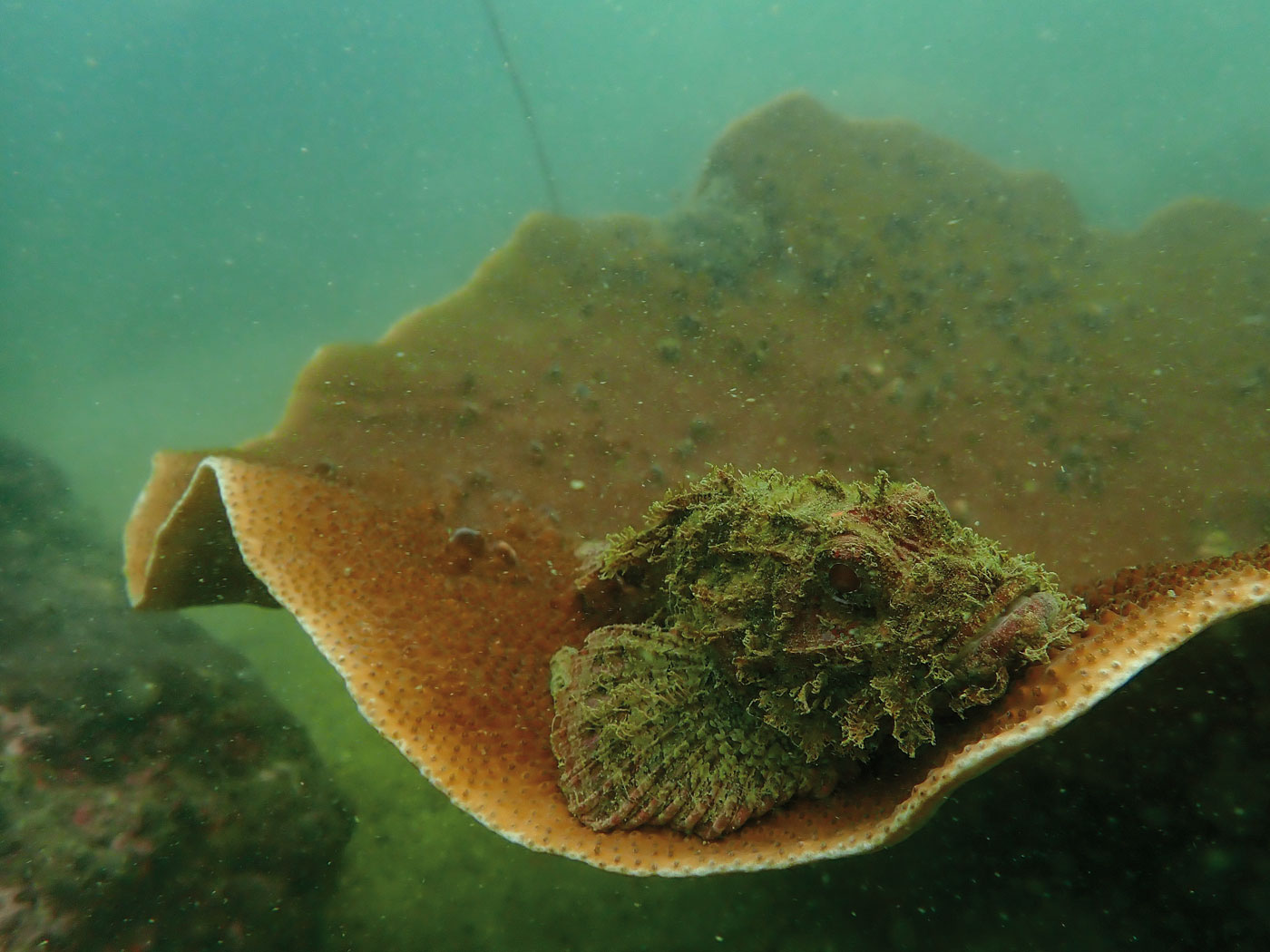
A scorpionfish Scorpaenopsis sp. from Goa's reefs lies nestled in the fold of a plate coral Turbinaria sp. Photo: Sumer Rao.
Three days later, we returned to see Coral Garden in all its glory. Silvery schools of ponyfish and mooneys trailed us as we dropped weightlessly to the reef bed below. Large boulder and encrusting forms of Porites and Favites corals stared up at us, their green oral discs reminiscent of emerald-studded jewellery. Flowerpot corals, waved their extended anemone-like tentacles in the tidal action, a beautiful dance that only we were privy to. Plate corals lay sprawled across the substratum, each under the watchful eye of a diminutive but highly territorial triplefin blenny. The reefs of the Konkan coast are diverse and breathtakingly beautiful. Even more so, if one takes into account that these habitats do not fringe some remote tropical island but in fact lie within driving distance from metro cities such as Mumbai and Bengaluru.
Banking On Tourism
The reefs of Malvan and Goa share many similarities, both ecological and social – from the wide range of corals and other reef-associated species that inhabit these sites, to the local livelihoods they support through long-running dive tourism operations.
Before our dives in Goa and Malvan in 2022, most of my diving was in the Andaman Islands. Having spent a season working with Lacadives, one of the oldest dive schools in the country, my experience curating a dive excursion was very different from what was on offer along the Konkan coast. The bulk of dive operations here comprise a form of diving that is considered high-impact, locally referred to as “tea bag diving”. Similar to the motion of repeatedly dunking a tea bag in hot water, dive tourists are taken underwater for mere minutes, before being brought to the surface, with the next tourist diver already kitted up and ready to go.
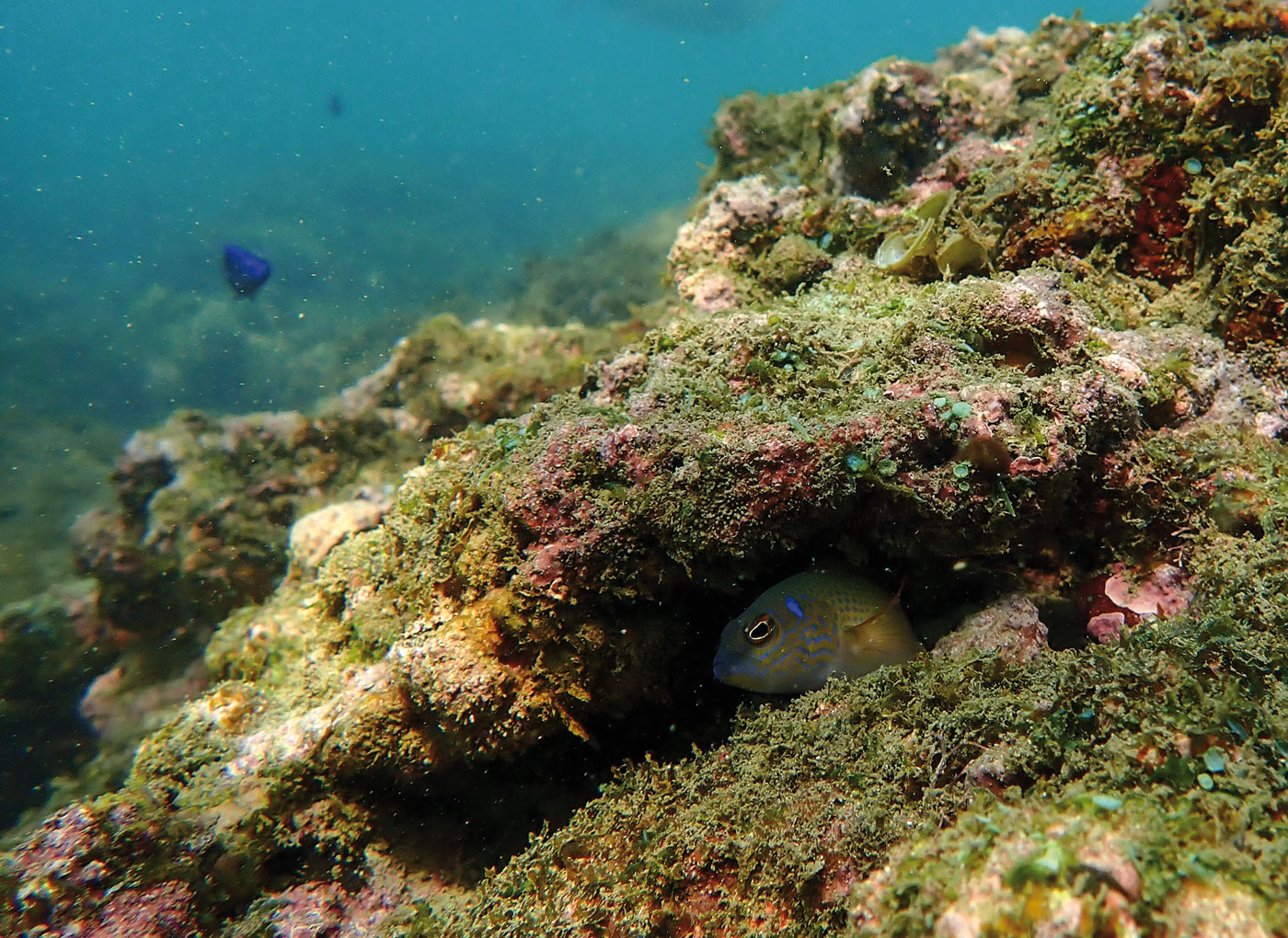
A bright dottyback Pseudochromis tapeinosoma occupies a crevice. Dottybacks are skittish fish and as the author watched, this individual flitted nervously between its chosen nook and the surrounding algal habitat to pick at the substratum, in search of small crustaceans and marine worms. WWF India surveys conducted since 2018 have recorded over 120 reef fish species in Goa, 90 in Malvan and over 150 in Netrani. Photo: Sumer Rao.
It was during one of our early survey dives in Malvan, at a site called Sargassum Forest, that I first witnessed a tea bag dive operation. As we were completing a transect, a dive vessel pulled in directly above us and its divers were in the water not minutes later. We saw novice divers grab corals in a desperate bid to steady themselves in this foreign environment. Tourists would stand on top of fragile plate and boulder coral forms, trampling structures which possibly took decades to attain their current size. I was horrified. But upon introspection, this quickly changed from a sense of dread to one of hopeful optimism.
SCUBA diving in India has historically been an activity that is reserved for the urban elite. By being both affordable and accessible, these tea bag dive operations are inclusive and allow for everyone to catch a glimpse of life underwater. Irrespective of privilege. I strongly believe that very few nature experiences come close to diving, in terms of fostering a sense of connection with one’s environment. As Sir David Attenborough puts it, “No one will protect what they don’t care about, and no one will care about what they have never experienced.” Diving along the Konkan coast offers just this – the chance for a large number of people to experience and fall in love with their neighbouring reefs.
This is where the conservation community must step in and its role should be two-fold. First, to work with local operators to encourage a transition towards responsible and low-impact operations, and second, to utilise this existing platform that brings in over 2,00,000 divers annually to raise awareness about the reefs and their significance, and the dive industry actively contributes towards monitoring efforts.
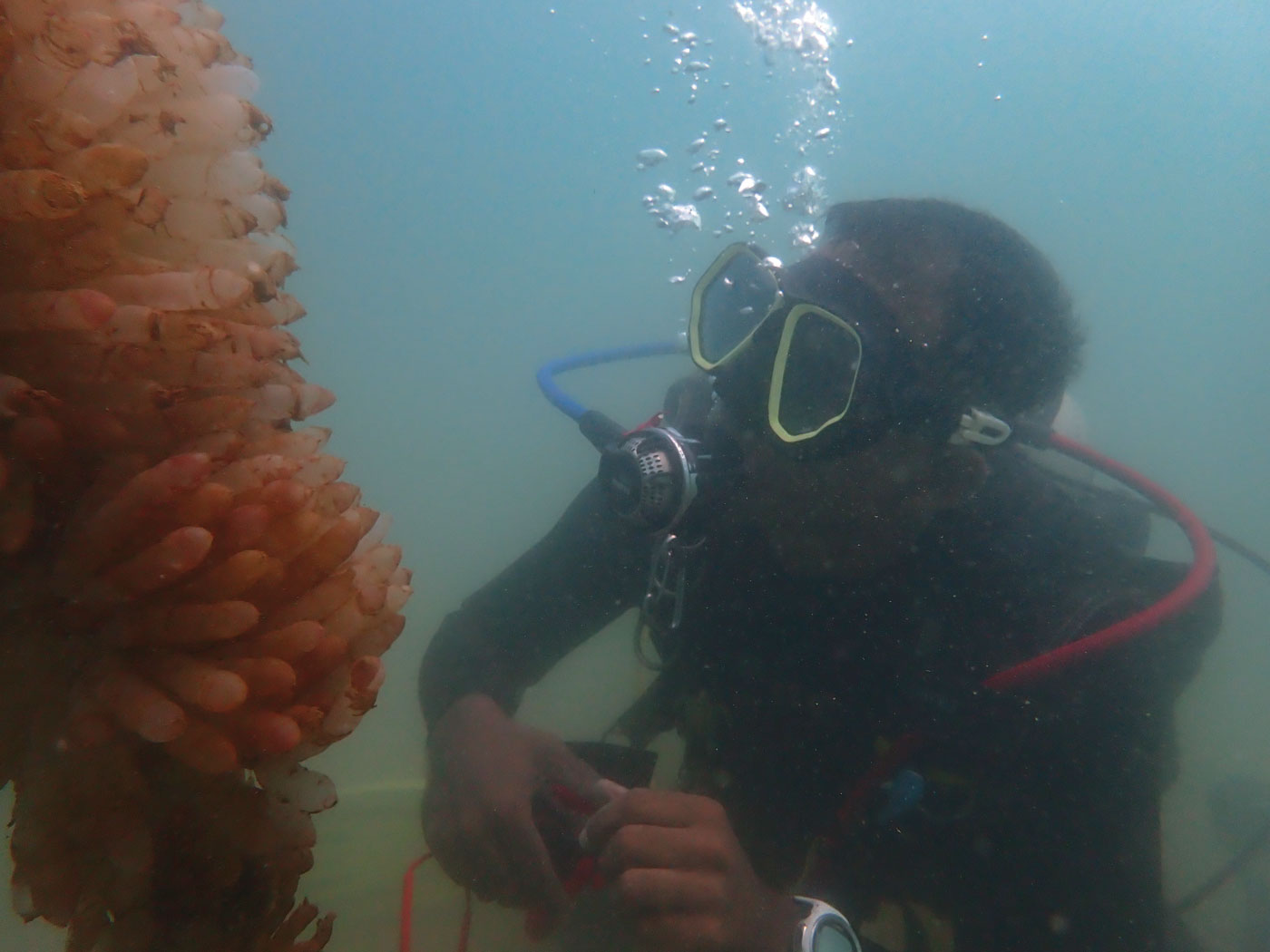
A dive professional observes squid eggs that have been laid on a mooring line at Suzy’s wreck, a popular dive site in Goa. He has been monitoring their development over the past couple of weeks, with some of the earlier batches having already hatched. Citizen-science led monitoring, which focuses on select species or high priority habitats, should be the driving force in our journey to better understand the Konkan reefs. Photo: Sumer Rao.
A Sustained Monitoring Effort
Despite their incredible biodiversity, economic value, and accessibility, the reefs of the Konkan region do not receive the same level of research and conservation attention as some better-known systems, such as those in the Lakshadweep or the Andaman and Nicobar Islands. This disparity most likely stems from their comparative lacklustre appearance. While the Konkan reefs might not boast the technicolour displays of their tropical island counterparts, these are important habitats that need to be better understood – especially when looked at through the lens of reef resilience in a rapidly warming planet.
Coral reef ecologists across the globe can breathe a sigh of relief as we finally enter the aftermath of the fourth global coral bleaching event in history, which has also been the most severe. A bleaching event is characterised when there is significant bleaching in all three ocean basins (the Atlantic, Pacific and Indian) within a 365-day period. According to National Oceanographic and Atmospheric Administration (NOAA) and the International Coral Reef Initiative (ICRI), over 70 per cent of the world’s reefs have been exposed to bleaching-level heat stress since January 2023.
The reefs of the Konkan coast are touted as being stress tolerant, and their corals are sometimes referred to as “super corals” for their ability to withstand temperature fluctuations and survive in turbid waters. This resilience can broadly be attributed to the species of corals inhabiting these sites.
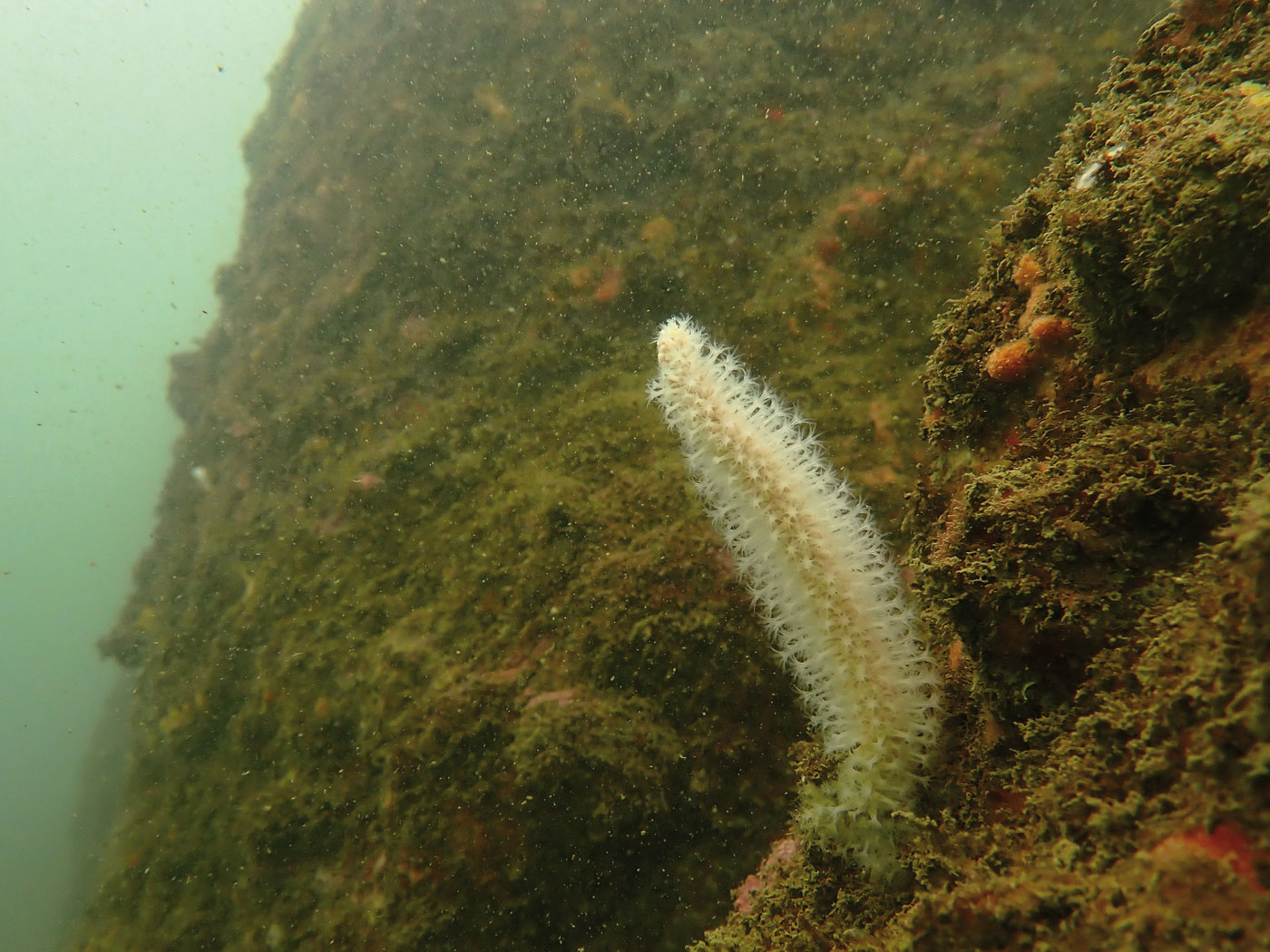
With its algal symbionts having abandoned the colony, the polyps of this freshly bleached devil’s whip coral Ellisella barbadensis remain fully extended as it attempts to secure sufficient food. Bleaching doesn’t have to be a death sentence for a coral colony. Studies have shown that zooxanthellae can return to their coral hosts, if conditions responsible for this stress response return to normal. Photo: Sumer Rao.
Corals belonging to the genera Favites, Favia, Goniastrea and Porites, amongst others, are generally recognised as hardy species across their range. However, truth be told, we simply do not know enough. In the absence of a systematic long-term monitoring, to formally document the extent to which colonies are impacted during warming events and how quickly they recover, records of resilience will remain anecdotal.
After having completed baseline biodiversity and threat assessments across sites, WWF-India’s vision for the reefs of the Konkan coast is now one of sustained and inclusive monitoring and management, led by the dive tourism industry, and supported by governing agencies and the conservation community. The next stage of effort will focus on establishing long-term protocols to better understand the ecological processes that govern the reefs of the Konkan region and identify areas of high conservation priority.
Sumer Rao A marine biologist and dive professional working with WWF-India as a Programme Coordinator for marine conservation and storytelling, his interest and experience lie in exploring community-based approaches to safeguard vulnerable species and habitats.






